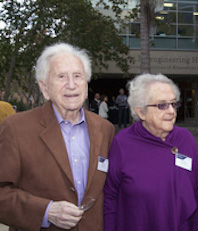In Memoriam: Dr. Arnost Fronek, MD, PhD
 We are deeply saddened to announce the loss of Arnost Fronek, MD, PhD, professor emeritus of the UC San Diego Department of Surgery and founding member of the American College of Phlebology. Dr. Fronek passed away on June 8 at the age of 97.
We are deeply saddened to announce the loss of Arnost Fronek, MD, PhD, professor emeritus of the UC San Diego Department of Surgery and founding member of the American College of Phlebology. Dr. Fronek passed away on June 8 at the age of 97.
Arnost Fronek was born in Slovakia in 1923, and as a young teenager developed an aptitude for electronics and radio repairs. Following the rise of the Nazi regime in the 1930s, his parents sent him to Israel, where he worked in a metal shop before matriculating at the Israel Institute of Technology to study the theory of wireless systems.
Following the start of World War II, Fronek learned that his parents had been exiled to the concentration camp at Auschwitz. He then joined the Czech brigade of the British Army, taking on a role repairing wireless systems in tanks, on occasion during active fighting. Following the end of the war, Fronek enrolled in medical school at Charles University in 1945, where a stint as a general practitioner in a large hospital in Bohemia inspired him to join the Cardiovascular Research Institute in Prague. He subsequently developed a passion for quantitatively measuring cardiovascular processes.
Using his background in electronics, Dr. Fronek began developing a method for determining cardiac output. His initial approach was to measure the change in electrical conductivity of a probe following a saline bolus, but eventually found thermodilution to be a more reliable metric. As a means of calculating cardiac output, Dr. Fronek hypothesized that a catheter positioned in the pulmonary artery would offer a way to sample the temperature change. The only question was how to reliably position it there. Following a series of experiments with inflated condoms in a bathroom sink, Dr. Fronek realized that flowing blood would carry an inflated balloon to a pulmonary vessel, where a catheter could then be lodged.
This moment marked the birth of the pulmonary artery balloon catheter, a project he would continue with Dr. Willam Ganz, a junior member of the institute. After both Drs. Fronek and Ganz escaped from Czechoslovakia, Dr. Ganz eventually partnered with Dr. Jeremy Swan in Los Angeles to produce the Swan-Ganz catheter. This catheter, as envisioned by Dr. Fronek, was widely used for decades to measure cardiac output, allowing accurate diagnoses and guiding therapy in millions of patients.
It was at Charles University that Dr. Fronek would meet his future wife and collaborator, Kitty Fronek, MD, PhD, who had enrolled in the medical school after surviving the concentration camp Terezin as a young teenager. At the Cardiovascular Research Institute, Dr. Kitty Fronek would study hypertension and conduct unprecedented experiments in blood pressure fluctuations in animals.
To provide more opportunities for their children – who were, as the offspring of educated parents, denied an education by the communist system – the Froneks left their careers at the institute to make a harrowing escape from Czechoslovakia. On the pretense of taking a vacation in Bulgaria, the Froneks risked detention by the authorities as they crossed the border into Yugoslavia and on to Vienna, where they lived with Kitty's friend from the concentration camp until they were able to successfully immigrate to Philadelphia in 1962.
Arnost worked at the University of Pennsylvania, while Kitty was placed in charge of the experimental surgery lab at Temple University, where she honed her considerable surgical skills and trained surgical residents. The couple then relocated to San Diego, where Arnost joined the Department of Bioengineering at the newly formed University of California, San Diego, specializing in peripheral vascular diagnostics. The eminent UC San Diego vascular surgeon, Dr. Eugene Bernstein, was enthusiastic about Dr. Fronek's understanding of electronics, bioengineering and cardiovascular physiology and encouraged Dr. Fronek to establish the first vascular laboratory in San Diego.
Dr. Arnost Fronek later published his comprehensive and oft-referenced 1989 text, "Noninvasive Diagnostics in Vascular Disease," which provided a thorough description of state-of-the-art techniques used throughout vascular surgery practices and in vascular laboratories throughout the world. Dr. Fronek contributed more than 140 publications to the literature, spanning an interval from 1955 to his most recent contribution in 2014 on the topic of noninvasive evaluation of endothelial activity in healthy and diseased individuals. With the encouragement of Dr. Bernstein, Dr. Fronek also began a successful sclerotherapy (varicose vein) practice that continued for more than a decade. His patients remember him for his gentle, kind nature and conscientious approach to their care.
Immersed in the field of venous disorders, Dr. Arnost Fronek collaborated with many European colleagues, most notably Jaroslav Strejcek of Prague and Vladimir Blazek of Aachen, Germany, with whom he worked on expanding the utility of photoplethysmography in the diagnosis of CVI. In recognition of his many contributions over the years, Dr. Fronek was honored with Germany's Humboldt Prize as well as the Conrad Jobst Research Award and the Honorary Member Award from the American College of Phlebology.
The Froneks enjoyed a marriage of 67 years until Kitty's death in 2018, just before her 93rd birthday. The UC San Diego Department of Surgery, the University as a whole, and the field of vascular surgery are all greatly indebted to their service and their discoveries.
